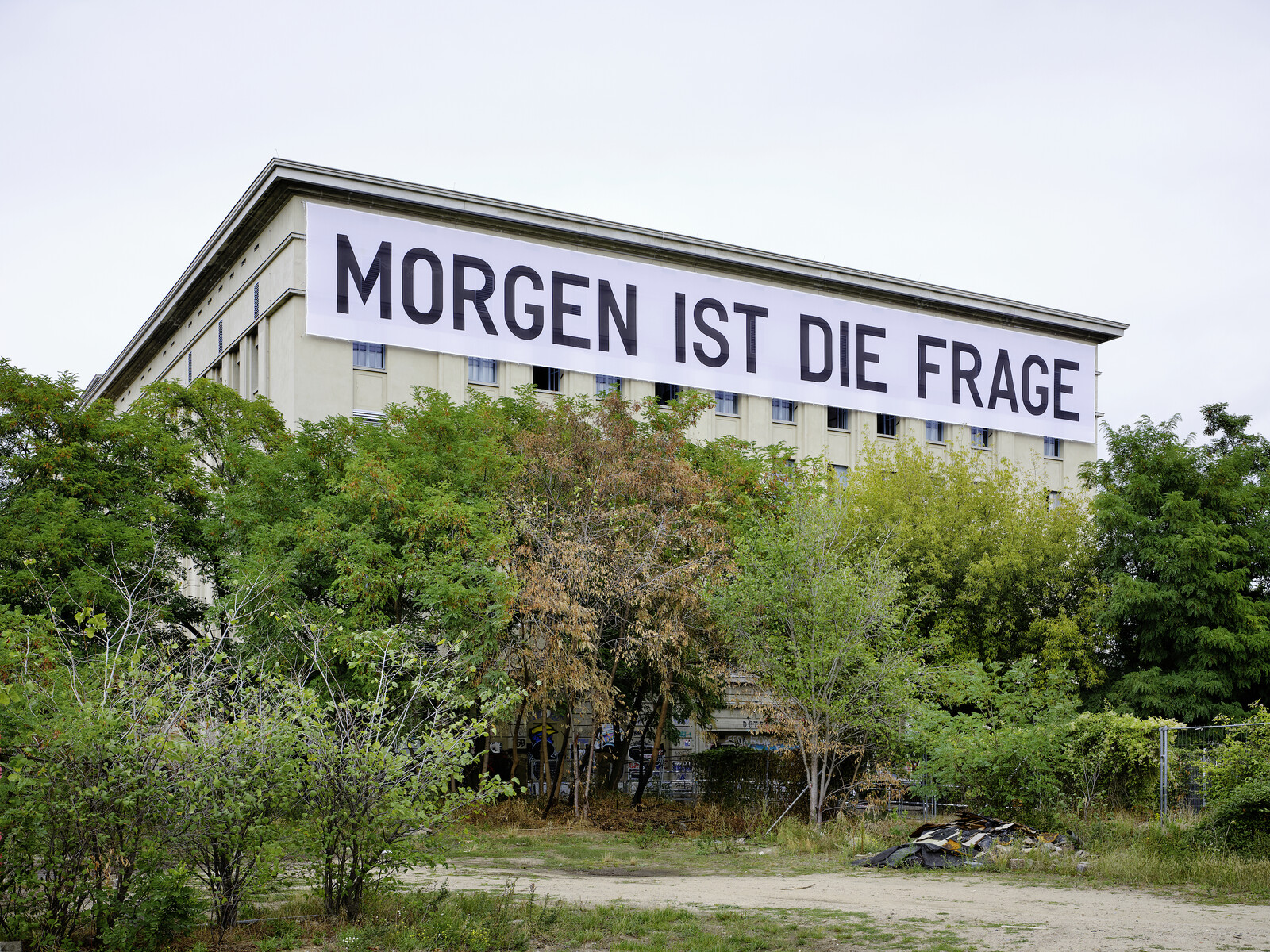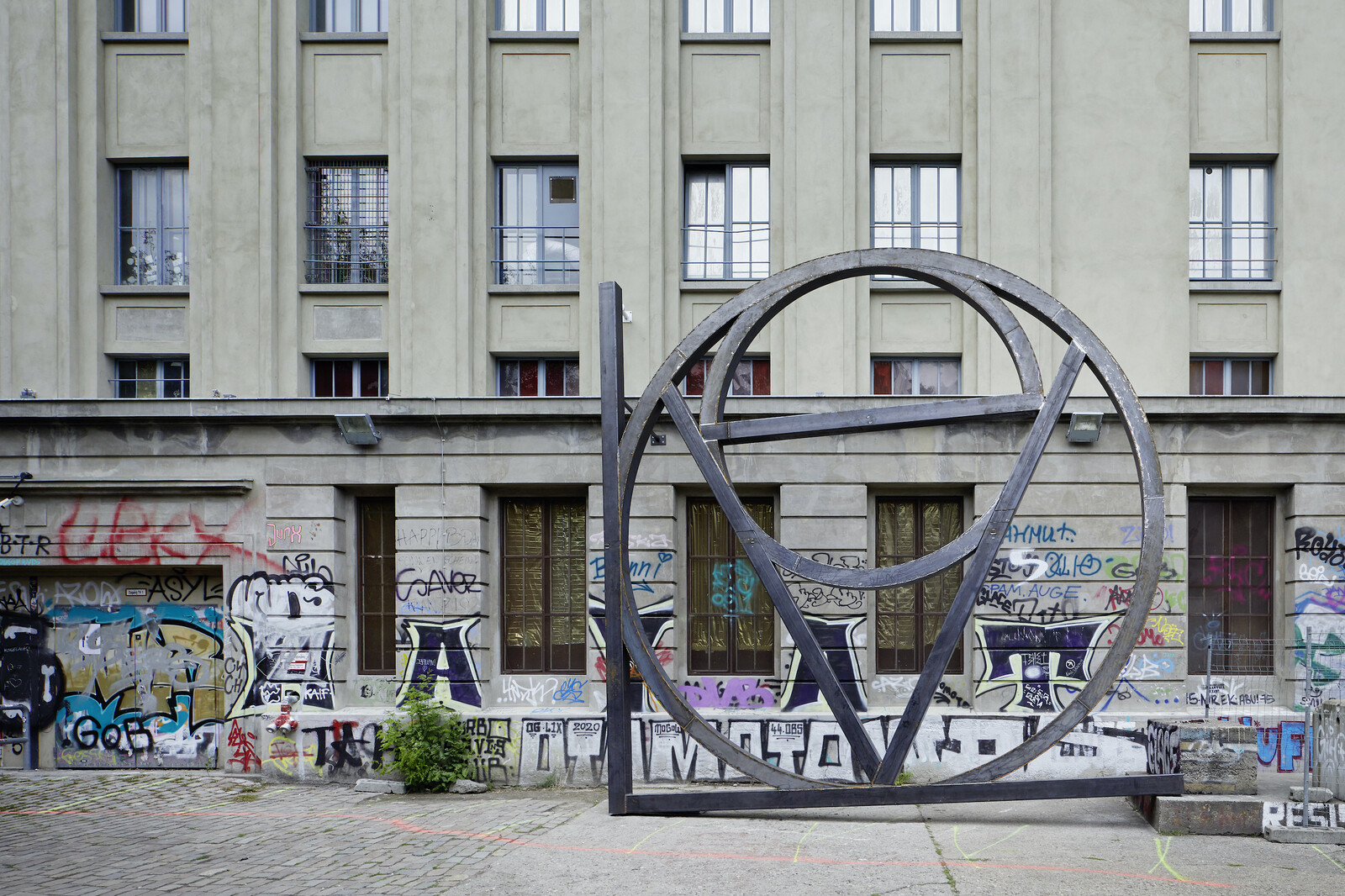“Morgen ist die Frage”—tomorrow is the question—reads the banner by Rirkrit Tiravanija which swathes the top floor of Berghain’s façade. The statement seems antithetical to the philosophy of the most famous techno club in the world. Before lockdown began and ravers were forced to find their fun at illegal parties in the parks of Berlin and the forests of Brandenburg, Berghain was where you went to forget about tomorrow. If you could brave the lengthy queue and possible rejection by the club’s notoriously mercurial door staff, days of hedonism lay ahead. But for now, the 3,500-square-metre venue, first a power plant and then a nightclub, has become an exhibition space.
When Covid-19 forced clubs and galleries to close in March, Berghain’s owners approached Karen and Christian Boros about mounting an exhibition to provide a platform for artists who live and work in the city. Funded by a 250,000 euro grant from the Berlin Senate, the show does not feature work from the Boros Collection—housed in a World War Two bunker in central Berlin that was itself once a techno club that hosted fetish parties—but they and Juliet Kothe, director of the Boros Foundation, are listed as co-organizers. As an overarching curatorial concept, however, “Studio Berlin” holds little water. Beyond the obvious fact that artists and techno producers alike have studios, it is difficult to see how this relates to what is simply a group show of disparate work.
The show includes pieces by 117 artists from Berlin’s art community—based in the city, but hailing from around the world—that differ greatly in concept and scale. It’s a testament to Berghain’s sheer size that this group show feels well-paced, not overloaded, and several works commune with the space. On the main dance floor the Funktion-One speakers play Ayilara, a sound piece by Emeka Ogboh (all works 2020). Where techno once boomed, we hear the mellifluous, everyday noise of a Lagos street. A clock hangs high above the dance floor, its hands moving backwards. The work by Khaled Barakeh, One Hour is Sixty Minutes and Vice Versa, is a reminder that the dance floor was once a place where time stood still. Verena Issel’s installation of cartoonish domestic objects TRAURIGE TROPEN (Version IV), in which multi-colored brushes are rendered in pliable, tactile materials, feels like stumbling on an animation brought to life. Other works speak more directly to the environment. Fixed to the wall at the end of a corridor, just off Panorama Bar on the third floor, is a metal plate that appears to have been pummelled with a sharp object. Nevin Aladağ made the indentations by dancing in heels. Christine Sun Kim’s Shoegazing comprises a series of black lines drawn on the floor, charting her course through the space and delineating how she experiences the club as a deaf person.
Much of the work resonates with Berghain’s history as a legendary den of iniquity. If there is a structuring principle at work, it’s the club itself. Upon entering, the usual club rules apply—a little sticker is placed over the camera on your phone and no recording or audio equipment is allowed. For the uninitiated, this will give them a taste of what it was like to enter the club in the old days. Now, however, there is the sense of entering a theme park, a simulation of the real thing—and yet the same reverence must be shown and the mystery of the interior must be preserved. There is something tiresome about the conceit. One leaves with the sense that the show was more about the aura of Berghain than the work of the artists who contributed.
If one purpose of the exhibition is to provide opportunities for those whose shows internationally and domestically have been cancelled as a result of Covid-19, perhaps it would have been of greater benefit to Berlin’s artistic community if a less conventional approach to the exhibition had been taken and less well-established artists given space. (Neither the markets nor the reputations of artists such as Jimmie Durham, Isa Genzken, or Danh Vō, for example, really need the exposure.) Those big names were presumably included to guarantee the ticket sales (standard entry is eighteen euros) that will keep Berghain going. Those included in the show have given of themselves generously to keep a space they love alive. It is less clear how this exhibition, overshadowed by the quasi-mythical status of a Berlin institution, benefits the artists themselves.

